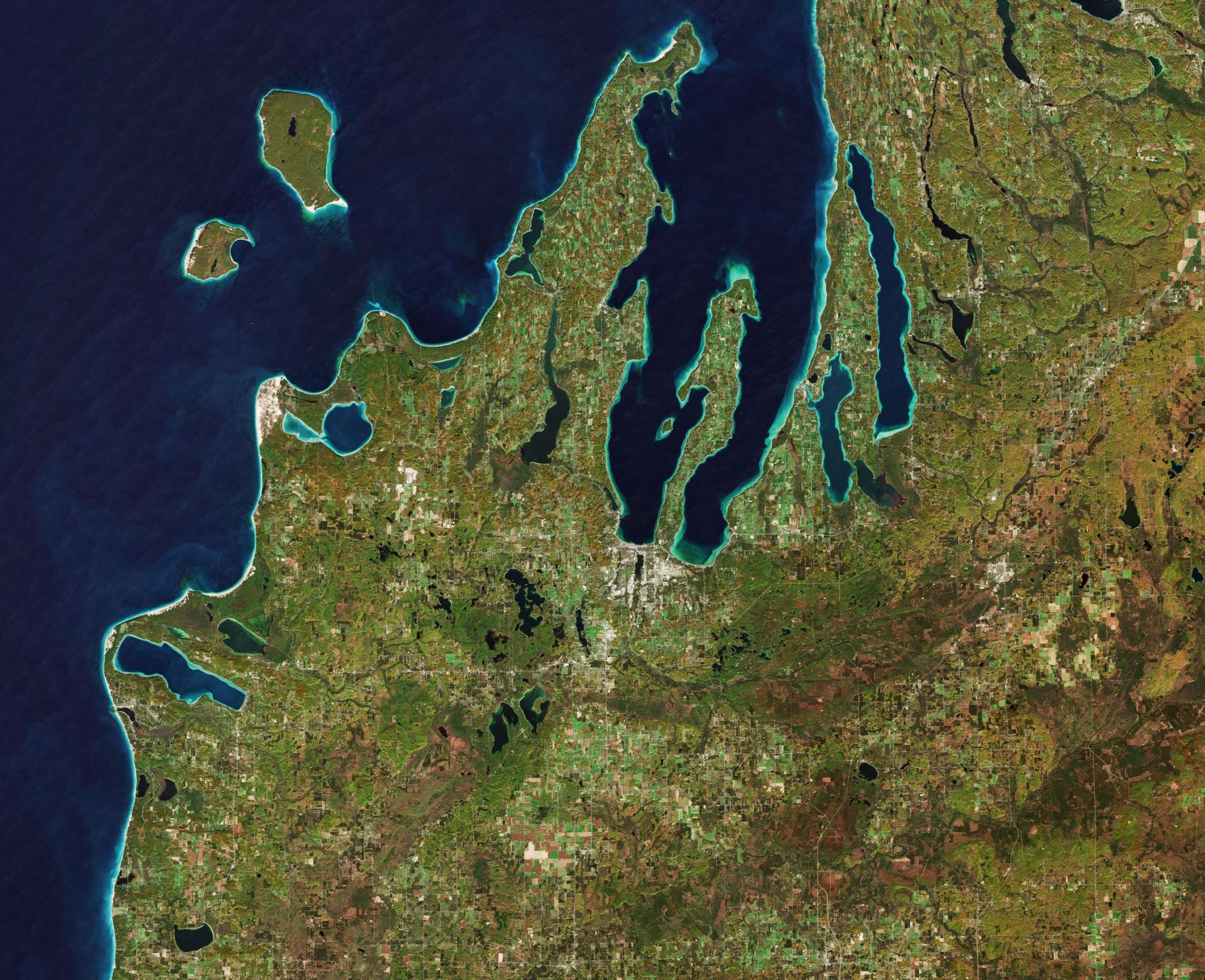La missione Sentinel-2 del programma europeo Copernicus ci porta sopra la penisola di Leelanau sulla costa nord-ovest del Michigan settentrionale (USA).
La regione è modellata dal proifilo di dolci colline e grandi bacini interni originati da ghiacciai circa 20000 anni or sono e che costituiscono la base di grandi terreni agricoli. La massa d’acqua che circonda la penisola è il Lago Michigan, uno dei cinque Grandi Laghi del Nord America e l’unico collocato interamente all’interno degli Stati Uniti.
Nell’immagine il colore turchese chiaro indica la presenza di sedimenti, alghe e clorofilla nelle acque più basse lungo la costa. I colori più verdi visibili nel lago Leelanau a nord, il lago Platte ad ovest e diversi bacini d’acqua interni sono caratterizzati da una combinazione di elevata presenza di piante e clorofilla.
Lo Sleeping Bear Dunes Lakeshore si estende per circa 55 km lungo la costa della penisola ed è visibile con una colorazione marrone. Il nome deriva da una leggenda Ojibwa, in cui si narra di una mamma orsa e dei suoi due cuccioli che fuggono nuotando attraverso il lago, cercando di sfuggire a un incendio boschivo. Durante la fuga accade la sparizione dei due cuccioli e il racconto narra dell’attesa del loro riaffiorare per settimane da parte della orsa, prima di essere vinta dal sonno per non svegliarsi mai più. Colpito dalla sofferenza dell’orsa, il racconto parla di un potente spirito che ha ricoperto il corpo dell'animale con la sabbia per poi sollevare i due cuccioli sul pelo dell’acqua, creando così le isole di Nord Manitou e Sud Manitou, visibili a nord della penisola.
Una spiegazione realistica dell’origine dello Sleeping Bear Dunes è tuttavia di natura geologica. Durante l’ultima Era Glaciale i ghiacciai si espansero verso sud dal Canada, ricoprendo questa zona con strati di ghiaccio. Durante questo processo vennero depositati nell’area grandi quantità di sabbia e rocce. Quando il ghiaccio si è ritirato e si è sciolto ha lasciato visibile il terreno collinare che esiste oggi lungo il lago.
La zona è attualmente molto frequentata per attività di escusrionismo ed arrampicate.
Questa immagine è stata acquisita il 18 ottobre 2018.
Scarica immagine MediumRes (18,97 MB - .JPG)
Scarica immagine HighRes (306,19 MB - .TIF)
---
Leelanau Peninsula
The Copernicus Sentinel-2 mission takes us over the Leelanau Peninsula on the northwest coast of Northern Michigan, US.
The region is shaped by rolling hills, large inland lakes shaped by glaciers around 20 000 years ago which form the basis for great farmland. The body of water that surrounds the peninsula is Lake Michigan, one of the five Great Lakes of North America and the only one located entirely within the US.
In the image, the bright turquoise in the water shows sediments, algae and chlorophyll in the shallower waters along the shore. The greener colours visible in Lake Leelanau to the north, Platte Lake to the west, and several inland bodies of water are due to a combination of a high chlorophyll and plant content.
The Sleeping Bear Dunes Lakeshore extend for around 55 km along the coast of the peninsula, and is visible in light brown. The name comes from an Ojibwa legend in which a mother bear and her two cubs swim across the lake trying to escape a forest fire. The two cubs are said to have disappeared in the process, and the mother bear waited for weeks for them to re-surface before finally falling asleep and never waking. Touched by her suffering, a powerful spirit is said to have covered her with sand, and raised the two cubs above the water, creating the North and South Manitou islands, visible north of the peninsula.
A more realistic explanation of the creation of the Sleeping Bear Dunes is geology. During the last Ice Age, glaciers spread southwards from Canada burying this area under sheets of ice. During the process, piles of sand and rock were deposited in the area. When the ice retreated and melted, it left the hilly terrain that exists along the lake today.
The area is popular for hiking and climbing.
This image was captured on 18 October 2018.
(Fonte: ESA - Image of the week: "Leelanau Peninsula". Traduzione: Gianluca Pititto)
Copia qui lo "short link" a questo articolo
www.geoforall.it/{sh404sef_shurl}




